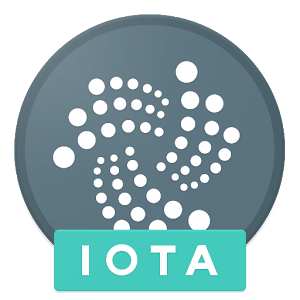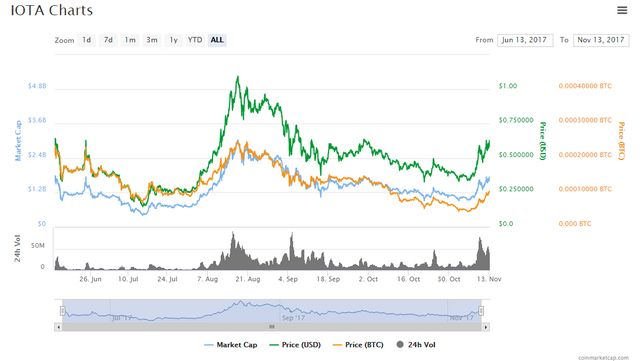BlockTech: IOTA - Going beyond the blockchain!
Welcome to the second article of my BlockTech series! Today, I will be presenting IOTA which revolutionizes "blockchain" technology and provides a great economy for the future of the Internet of Things (IoT) sector. You can check out the previous post in the series 'Cobinhood - Zero-fee, true high-frequency trading!' at the following URL: https://steemit.com/cryptocurrency/@noly/blocktech-cobinhood-zero-fee-trading-with-true-high-frequency-trading

What is IOTA?
IOTA provides efficient, secure, lightweight, real time micro-transactions without fees. It is open-source, decentralized cryptocurrency, engineered specifically for Internet of Things, its real-time micro transactions and providing ecosystem that is ready and flexible for scale.
IOTA is a new cryptocurrency that focused on Machine-2-Machine (M2M) transactions. The main purpose of IOTA is to serve the machine economy by enabling feeless M2M (Machine-to-Machine) payments.
IOTA goes beyond blockchain. It is the first cryptocurrency that provides the whole ecosystem based on blockless blockchain utilizing a technology called Directed Acyclic Graph (DAG). Their DAG is known as the Tangle network. Below, we will dig into the Tangle a bit more.
Below is a brief primer to IOTA.
Revolutionary Technology
The technology behind IOTA brings 3 major revolutionary features to the cryptoverse.
- Zero-fee transactions.
- Infinite scalability.
- Ability for offline transactions.
The Tangle (Direct Acyclic Graph)
Tangle vs. Blockchain
What is the Tangle? With simple words we would say, that Tangle retains the blockchain features of the distributed ledger and secure transactions, but does not work with blocks. Instead of blocks (regular blockchain), Tangle uses the form of a Directed Acyclic Graph (DAG).

Directed Acyclix Graph (DAG)
Why is DAG better than blockchain? Because DAG technology enables various features like zero-cost transactions, infinite scalability, and offline transactions. Blockchain simply cannot do this and to my knowledge aren't capable of it.
Traditional blockchain technology works like this:
Various transactions are bundled in each block. After that, they can be verified by miners. That means that with increase of transaction there will be more jobs for miners. What we experienced so far with Bitcoin (and Etherium as well), that also means increase of transaction fees and in the case of some technologies, long transaction wait times.
A Tangle works like this:
In the Tangle, each transaction forms a new block and it is verified by itself. To be able proceed this verification, it has to first verify two randomly chosen transactions on the network.
IOTA’s architecture is inherently decentralized on a level that no blockchain can match, due to the fact that users and validators are one and the same in Tangle. Of course, there is a cost of every transaction, but that cost is “to verify other transactions”. The idea behind is very clear: IOTA creates self-sustainable economy that is based on demand. That's why we talk that Tangle run with zero-cost transactions.
The DAG has yet another benefit. No limit for scaling. The problem that we face right now with cryptocurrencies (based on blockchain) is scalability. The IOTA network could become indefinitely scalable with zero cost because every new transaction verifies two new transactions in the network. When more and more people join and send transaction, IOTA will grow and scale smoothly. Actually, the more users and devices on the network, the faster transactions can be completed. This is due to what was stated above, every transaction confirms 2 other random transactions. A Tangle brings solution for scalability with zero cost, that is revolutionary!
Here is a great video by a YouTuber called Crypto Made Simple. This covers the basics of IOTA and discusses the Tangle technology in simple terms.
IOTA in the Real World
There are many ways IOTA could be adapted to real-world use cases due to it's ability to process microtransactions (fractions of a penny), and the other features we've discussed above. Some of those use cases could be those such as the following:
- Sensors selling data in real time to computational stations.
- Sensors buying analytical capabilities of computational stations.
- Consumers buying electricity from any kind of electricity generating prosumer.
- Devices buying storage space.
- Devices buying bandwidth on demand, with no need for subscriptions.
- Ensuring data integrity for IoT devices.
- Ensuring tamper-proof event logging for any kind of infrastructure.
- E-voting and e-governance.
IOTA Price Chart
Accurate as of Nov. 12, 2017. $0.625345 per IOTA at the time of writing.


I think we've covered a good amount on IOTA and what makes their technology different. If you'd like more information please visit their website (listed below).
More Information
Website: https://iota.org/
Symbol: MIOTA
Popular Markets: Binance, Bitfinex
Support Me
Like my content? Be sure to follow and upvote! Also, I appreciate any donations greatly! These donations will help me with videos, website, and my future non-profit! 50% will be dedicated to future content and the other 50% will be going to my non-profit to help spread awareness and adoption of blockchain technology through local meetups/classes.
BTC - 1FWHFL3HV7sWV3U8KvTkw4VhTsvoWTrwaY
ETH - 0x60e39a8c6a849283ec76a0ac8d73dd6188c983fc
LTC - LhK3NN8rS6n6okSqd1yGaUvrNmv9xDUqqR
You can also send Steem/SBD to @noly.
Sources
https://iota.org/
https://medium.com/@Cobinhood/what-is-cobinhood-cob-and-why-should-you-care-e5662ab5361d
@OriginalWorks
The @OriginalWorks bot has determined this post by @noly to be original material and upvoted(1.5%) it!
To call @OriginalWorks, simply reply to any post with @originalworks or !originalworks in your message!